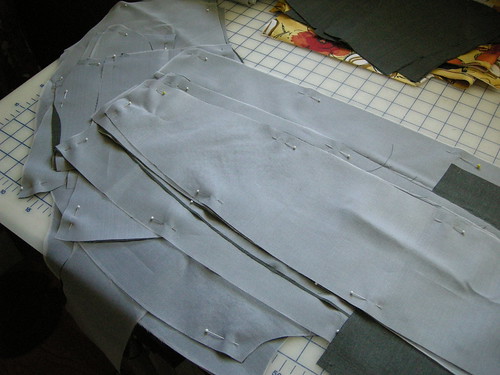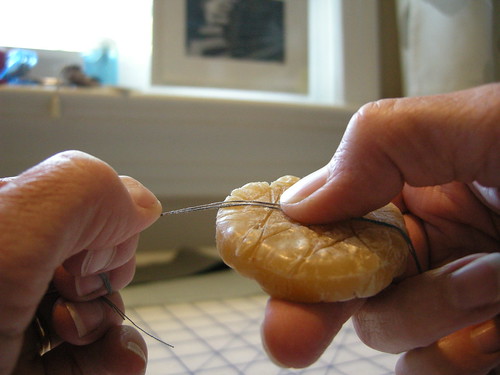I have learned over the years to take my time in the preparation of my projects. Before actually starting to sew Vogue 8718 and its coordinating skirt, I had to:
- Choose the fabric, including all the inner layers (lining, underlining, and interfacing). I eventually decided to underling with white silk organza, even though I have some grey in stash, because the grey is a little too stiff and substantial for the tropical weight wool.
- Prep the fabric. This included steam shrinking/pressing the wool with my super-duper gravity feed iron, while checking and marking with safety pins all the little flaws. I also had to iron the Bemberg lining and the silk organza, which had been sitting in a bin folded up for quite some time.
- Cut all layers. In this process I had to pay attention to the many jacket pieces which had to be cut x 4 (the peplum and front edge pieces are self-lined), which needed to be cut x 2 in the wool and x 2 in lining, and which had to be cut as well from interfacing. I decided to underline all the body pieces that were not being interfaced with my chosen fusible, and to cut the sleeve underlining on the bias to avoid stiffness in the draped/pleated sleeves. Other decisions (like whether to use the organza selvedge to stay the front edges or a fusible tape, and whether to use the slightly stiffer grey organza to underline the peplum as well) will be made as I go.
- Go and buy grey thread. I also bought a spool of matching topstitching thread because I think I want to topstitch at least some seams and/or edges, although I haven't quite decided
Right now, I am at the stage of having pinned the organza underlining to the wool. True confession time: I am not going to hand-baste the organza to the wool along the seam line (!!) - I am going to machine-baste. So far I am still of the view that life is too short for hand-basting and thread-tracing and the like. I've had entirely acceptable results before without having resorted to these somewhat laborious techniques and I'm not convinced that the effort is worth the possibly-more-beautiful results. Feel free to try to convince me otherwise...
Despite my unwillingness to go to the trouble of thread-tracing, I have (as you may be able to tell from some previous projects) come around to the view that an aversion to hand-sewing is not consistent with my objective of producing well-sewn and properly-finished clothing. I took an on-line class from Susan Khalje last year through PatternReview. It was just in time for to give me what I needed to know for making my not-necessarily-black-not-necessarily-a-dress cocktail outfit for last year's PR Weekend in Montreal.
Two things of which I am now completely convinced re hand-sewing:
- Waxing the thread makes it a far more enjoyable process. Say goodbye to knots and tangles. Waxed thread pulls smoothly through the fabric and is less likely to break or tie itself in knots while you are trying to work with it.
- Using better quality needles will also make hand-sewing a better experience.
And there is one thing I am not completely convinced of yet, but am working on:
- Using a thimble may make one a better hand-sewer.
Here's how to wax thread. Cut some lengths of your chosen colour, about 40-50cm (15"-18") long. Hold them firmly at one end, and pull them through a block of beeswax. You can see I'm holding the thread against the wax block, and pulling down slightly as I pull the threads through. Repeat a few times, to ensure that there is a more or less even amount of wax on all the threads for their entire length.
Then put the thread between two sheets of paper towel. Go over the paper towel with a dry iron. You'll see the shape of the threads on the outer sheet as the wax melts into the thread and onto the paper towel.
Simple. The result is a slightly stiff, strengthened and smooth length of thread. It's easier to thread your needles with waxed thread, and generally easier to use.
I splurged on some Japanese hand-sewing needles which I purchased from Susan Khalje. They are pretty expensive if you measure by the pound but I figure one package will last years if not my lifetime. These needles are very fine but strong, with a tiny hole (good for hand-eye coordination) and they feel very luxurious somehow.
The whole thimble thing still feels very awkward but I am going to persevere until I get the hang of it and it seems natural. I was doing some hand-sewing recently without a thimble and managed to practically shred my fingers because the fine ends of the Japanese needles are quite pointy! I do not think I could tolerate the standard closed-end thimble but in my sizeable thimble stash there was one little tailor's thimble with an open end which I like a lot better.
Googling "tailor's thimble" reveals that they are available for sale in different sizes, and how to use one. Based on the pictures on the English Cut, I clearly need to work on my technique.








Thanks for the link to the English Cut site - great post!
ReplyDeleteI really don't mind hand sewing - even enjoy it sometimes, but thread tracing is not my favorite. That said, I DO notice a difference in my results when I do thread trace. You've given me a smidge more inspiration to try it a smidge more often ;D
Nice post which highlights all the steps in "slow sewing". Thanks for the links on thimble use. I'm going to try to be more diligent about waxing my thread. I usually run it through my lips and pick up some Carmex. I know, gross!
ReplyDeleteI took an in person class with Susan more than a year ago and am so in love with those needles. And yes, I need to thread trace my next project which I don't enjoy as much as doing some quiet time handsewing.
ReplyDeleteMy daughter and I are both following your blog with great interest. Thanks for the tips on basic sewing techniques. This may be a really dumb question, but ... why would one expect to get better results with hand basting than with machine basting? I can understand why hand sewing would give better results for, say, making a shoulder pad where you want to get an exact gradient for the batting (batting? is that the right word for the padding part of the pad?) But if you're just doing a straight stitch, I can't imagine why there would be a difference between hand and machine sewing, except that the machine stitches are more uniform. Which seems like a plus rather than a minus.
ReplyDeleteTotally agree with you about the waxed thread. Much, much easier to sew with it.
ReplyDeleteThe preliminaries are essential steps aren't they? I cna't wait to see the construction of this jacket.
ReplyDeleteThe English Cut blog is very inspiring has been in my favourites for a long time now.
I love using waxed thread, it makes habd sewing much more fun. As for thimbles, I am just unable to use one.
Concerning thread tracing, I used to think that is was a mandatory chore to get professionnal results. I tend to think differently as I am experiencing with more accurate 3/8'' seam allowances or even 1/4'' for enclosed seams. I must say that I am quite happy with the result. It improved both the quality and productivity of my sewing. I am even trying to avoid pins as much as possible. I know that it may sounds heretic to "couture" addicts. May I suggest the reading of Fashion Incubator for more on these topics.
This is a great post thanks! I have used waxed thread but haven't ironed it.
ReplyDeleteHave you thought of using a leather thimble? I use these exclusively as they mold to your finger and gives you a more natural feel when doing hand work. It has a small metal plate in the tip of the thimble and this does the job of providing leverage and protecting your finger. They are great.
ReplyDelete